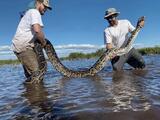The strange phenomenon of sleepy iguanas this Christmas in Florida

Catatonic iguanas: it’s become one of the stranger sights in South Florida during the occasional wintery cold snaps.
This Christmas, as temperatures plunged into the 40s at the weekend, reports began to appear of iguanas falling out of trees and landing on sidewalks and by swimming pool decks.
While the north of the country was dealing with deadly snow blizzards, in Florida it was the large iguana population that was suffering the most.
The non-native reptiles which were imported decades ago from warmer tropical places, clearly aren’t designed for the cold. When temperatures get into the 50s their bodies go into a semi-dormant, comatose state.
“In the 30s it’s really bad for them. In the 40s it just stuns them and can survive that way for hours until the sun comes out,” said Manuel Hernandez, a South Florida reptile trapper.
"If the weather stays cold too long they can suffer organ damage and fail to recover," he added.
Iguana winters in Florida
Hernandez was called by a neighbor in Homestead on Christmas Day who found an iguana from its hind legs upside down on an avocado tree. He put it down using carbon dioxide gas. Under Florida law it is illegal to catch and release non-native species and they are required to be euthanized.
Peter Verbeeck, a resident of Key Biscayne near Miami, spotted several iguanas while walking outside his condominium on Christmas Day. Later that day, visiting friends in Lake Wales, near Palm Beach he said his hosts found several iguanas lying on their backs in the garden.
“It appears they fell out of the trees from rigor mortis,” said Verbeeck, a former Rotary Club Southeast Florida and Grand Bahamas district governor. “One of the children picked one up and brought it into the house where it became part of the Christmas tree decorations,” he added.
On Christmas Day, Brian McNoldy, a climatologist at the University of Miami, posted a photo on Twitter of a lifeless looking iguana in his backyard. "I was walking around with a cup of coffee and enjoying the fresh air and saw this thing across the pool. I realized what it was when I got closer," he told Univision.
This December 25 witnessed the coldest maximum temperature (50f / 10c) on record in Miami, according to McNoldy.
A foot-long green iguana, cold and stiff, lay on the grass agonizingly near the heated pool at the Silver Sands motel, near the beach in Key Biscayne. Elsewhere, the normally highly visible iguana population, considered a pest by many homeowners, appeared to have vanished.
“When the weather gets cold they will burrow into the ground or under bushes to find warmth. Or they will just sit in the trees. The ones you see on the ground have usually fallen from thinner, outer branches, said Hernandez, aged 52, who has been trapping iguanas since he was eight years old.
Some will slip into shallow water which can be warmer than the outside air. “They'll sleep with their head sticking out of the water,” said Hernandez.
"Raining iguanas" in 2010
This Christmas is nothing compared to the winter of 2010 when there were so many iguanas falling from the trees in South Florida media reports referred to a “rain of iguanas.” The freezing conditions practically wiped out the population which took years to build back up. Iguanas breed once a year in the wintertime and a female can lay around 30 eggs at a time. A young iguana can start having babies before turning two years old and can live up to 12 to 15 years.



